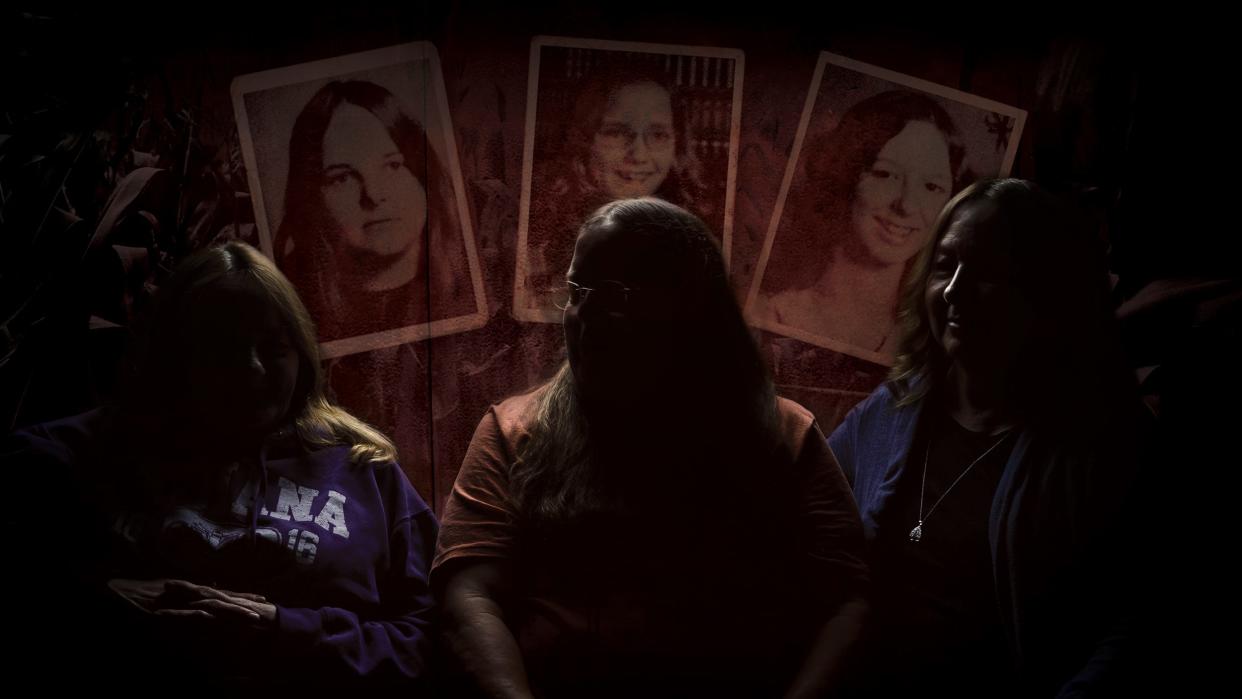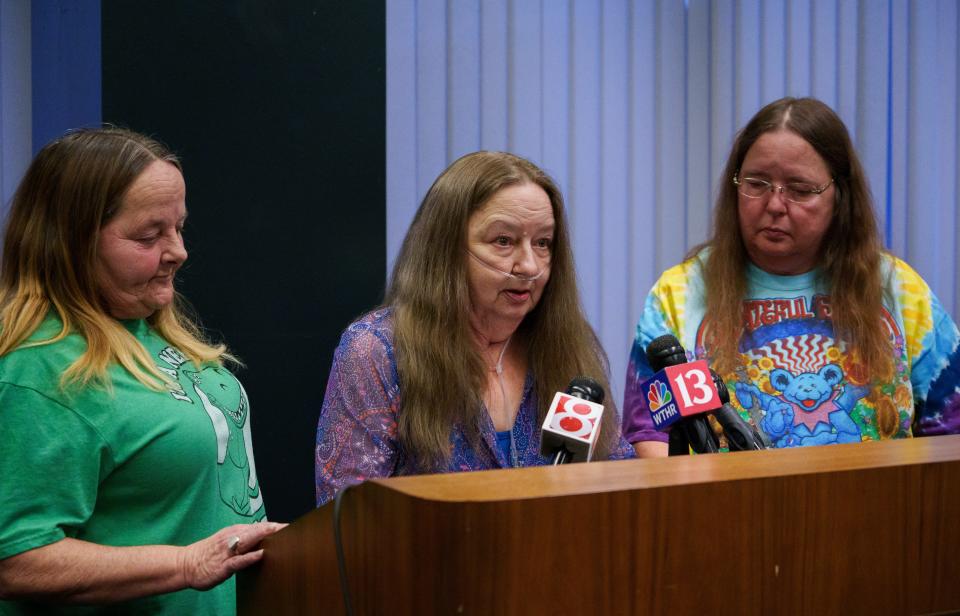A crack in the case: Can DNA testing give the monster a name?

Detective Sgt. David Ellison was running out of options.
Since 2018, the Indianapolis official had done his best to solve the 1975 kidnapping and stabbing of three young girls, and the rape of the youngest.

He’d met with Kathie Rottler, Sheri Trick and Kandice Smith, all of whom survived the attack. He’d collected their DNA and submitted it and the evidence for testing. He’d cleared one of the original suspects and ruled out another potential suspect. And he’d ensured the attacker’s DNA profile was added to a national database called the Combined DNA Index System (CODIS).
But Ellison still didn’t know who had committed the crime.
There was one more way to seek answers.
Ellison reached out to a friend for help securing funding for forensic genetic genealogy, which combines DNA testing with traditional genealogical research to generate leads in unsolved cases. It’s family tree meets the crime lab.
That process has solved hundreds of crimes across the country, including those of “Golden State Killer” Joseph DeAngelo, who is serving life in prison after pleading guilty in 2020 to 13 counts of first-degree murder and 13 counts of kidnapping. As part of his plea agreement, the California man also admitted responsibility for other violent crimes.
Ellison said forensic genealogical testing for Kathie, Kandice and Sheri’s case would cost about $8,000.
His friend connected him with Ashley Flowers, the founder of Audiochuck, an Indianapolis-based media company that produces crime-related podcasts. Flowers had paid for testing for cold cases before. She agreed to donate $6,000. The Indianapolis Metropolitan Police Department covered the rest.
In January 2023, the department partnered with DNA Labs International to complete the analysis. The Florida-based private forensic DNA laboratory handles thousands of cases each year, primarily for law enforcement and government laboratories.
Chief Scientific Officer Rachel Oefelein said the team extracted the suspect’s DNA from the evidence provided by Indianapolis officials, made millions of copies and sequenced it.
They uploaded the profile into FamilyTreeDNA and GEDmatch – two genetic ancestry databases that allow law enforcement use. Then the team began sifting through matches to find the suspect’s most recent common ancestor.
In July 2023, as DNA Labs continued its work, Ellison made a major move of his own: He retired from the police department.
But he didn’t close the door on the case, or on Kathie.
About a month after his retirement, Ellison learned the lab had found the profile of an unknown person who shared an extremely high percentage of DNA with the suspect.
IMPD Detective Charles Benner and Sgt. Columbus Ricks, who had taken over the case, were the ones who let Ellison know. Ellison helped them pull background information on the person who had submitted the DNA for someone else. That person agreed to connect police with the woman whose DNA had been submitted.
She was the suspect’s daughter.
The lab also found a second profile with a high shared percentage of DNA – the suspect’s son. The siblings had different mothers but the same father.
Both agreed to cooperate, providing their DNA to police and identifying their father.
To close the case, detectives still needed to confirm the man’s connection to Indianapolis and his location around the time of the attack.
Part 3 quicklink: ‘Your case is NOT forgotten.’ But it keeps turning up cold.
The monster

By the end of 2023, it was official: The monster had a name.
Ellison asked Kathie, Kandice and Sheri to meet with him and the other detectives. He was coy about why.
I don’t think you’re going to be disappointed, he told Kathie. We need to talk one more time.
His words sounded promising, but Kathie tried not to get her hopes up. Were police abandoning the case for lack of information, or had they found the man who did it? The women agreed it could go either way.
On Jan. 2, 2024 – more than 48 years after the crime and five years after Kathie had begged Ellison to look at the cold case – the survivors reunited for another trip to the police department.
Sheri wore a black T-shirt emblazoned with “Every little thing is gonna be alright” in rainbow lettering. The 60-year-old hopped into her silver Kia Soul and picked up Kathie first and then Kandice. They remained mostly quiet on the drive.
After parking and clearing security, the women filed into a conference room with a wall of large windows on one side facing downtown Indianapolis. They were joined by the four police officials – Ellison, Spurgeon, Benner, Ricks – and two representatives of IMPD’s Victim Assistance Unit.
The detectives launched into their reason for meeting. They reminded the women of recent efforts, including sending the evidence to DNA Labs for testing. They explained how the lab had located the man’s children through genetic ancestry databases and how police had confirmed his identity.
Then they told the women who he was: Thomas Edward Williams, born May 21, 1934.
They touched on how the Indianapolis native had tangled often with law enforcement. In 1966, nine years before he hurt the girls, Williams donned olive-drab military fatigues and a rubber Dracula mask to rob a bank at gunpoint in Phoenix. After collecting $3,395, he fled in a stolen car. But he was arrested 10 minutes later in a nearby parking lot after witnesses saw him changing clothes. Williams pleaded guilty to bank robbery and served about five years in federal prison, getting parole in 1971.

By 1975, the year the girls were attacked, Williams was back in Indianapolis. The 41-year-old lived just four miles from Kathie and Sheri’s childhood home.
He briefly married but left Indiana again by the end of 1976, according to divorce filings. Williams reappeared in 1977 in Texas, where he was arrested for and convicted of a string of robberies.
It would be the last time he experienced life outside prison walls. He would no longer be a threat to the women, or anyone else.
Williams died of natural causes in prison in Galveston, Texas, on Nov. 13, 1983. He was 49. He is buried in Captain Joe Byrd Cemetery, his grave marked by a cross with only his inmate number and the date of his death.
Toward the end of the presentation to the women, detectives pulled up an old photo of Williams on a cellphone and placed it below a series of composite drawings from 1975 and 1976 based on Kathie, Kandice and Sheri’s descriptions of their attacker. They also showed the women Williams’ mugshots from Texas.

Kathie’s gaze snagged on one showing Williams’ side profile. It was the face she’d seen next to her in the station wagon so many years ago. Then, she was sure police had the right man.
Later, Ellison would give Kathie much of the credit.
“If families stop calling or don’t call, then it reduces the odds that their case is going to be solved or progressed,” he said. “She was steadfast in never giving up and was that point person. If she had not done what she did, I don’t think it would be solved.”
Her efforts also may help another grieving Indiana family.
Keeping hope alive

Morgan County officials are looking into whether Williams was connected to the 1975 abduction of 11-year-old Cheryl Bolin.
She disappeared around noon on the day Kathie, Kandice and Sheri were attacked, while riding her bike home from a friend’s sleepover. Cheryl’s body and some of her belongings, including clothing and a bedroll, were found about six months later near a pond in Vigo County, about 100 miles from the cornfield where the girls were assaulted.
Chief Deputy Terry Keith of the Morgan County Sheriff’s Office, who has worked on Bolin’s case for years, said officials are checking the girl’s belongings for DNA to compare to Williams’.
“At this point,” Keith said, “we’re just kind of all waiting.”
Epilogue

The man who hurt Kathie, Kandice and Sheri was dead – had been dead for decades, since even before the first cold case investigation in 1990. Yet his crimes cast a shadow that extended long past his death.
In the weeks and months after meeting with police, the women wrestled with complex emotions.
“It’s put peace within my heart,” Kandice said during a news conference in January. “And it also gave justice to my parents and brother that’s passed as well.”
Sheri said she forgave Williams because “I had to, in order to continue to live my life.” Yet she couldn’t forget what he did. She is planning a trip to Texas to spit on his grave.

“He spit on me, let me spit on him, see how he likes it,” Sheri said.
When she sat down with USA TODAY in March, Kathie said knowing who attacked them was “worth the wait.”
But it was also unmooring.
She, more than the others, had relentlessly pursued answers. The 63-year-old had fought for so long, had given so much of herself trying to keep the case open – even after family and friends told her to stop. Kathie wondered aloud: Was it worth it? She didn’t know.
She turned to her sister Sheri, sitting close beside her on a black couch.
“I did it for you,” Kathie said.
“I’m glad you did,” Sheri replied.

“I told you something when you were getting out of the car,” Kathie reminded her sister of that night so long ago. “I told you he had a gun and to be brave and listen to him. I didn’t want him killing you.”
Sheri looked down, biting her lip as she held back tears.
Kathie reached over and clasped her sister’s left hand, pulling it onto her lap. They shared a tearful smile.
“I always wondered how you handled seeing what happened,” Sheri said. “I don’t know how you handled it.”
“God,” Kathie replied.
The sisters told USA TODAY their flashbacks and emotional triggers intensified after learning Williams’ name.
“It’s not so much fun going through it day by day by day by day,” Sheri said.
The smallest things can snap them back to that night – a song they heard in the hospital, a stray word or the texture of a shirt. Their scars.
They don’t yet know what the future will hold, but there is freedom in knowing Williams is gone.
“All those years, my adult life, I’ve been pushing to get him found,” Kathie said. “It’s like, what do I do now? I know I got a new journey, but I don’t know which direction it’s going to take me.”
Read the entire series: Slasher: A vicious abduction and assault of three teens that stayed unsolved for decades
This article originally appeared on USA TODAY: Can DNA testing crack this Indiana cold case after decades?
